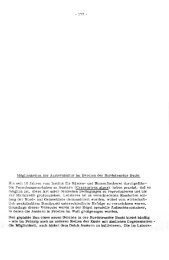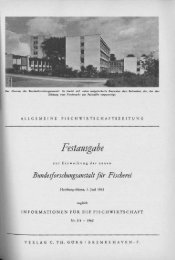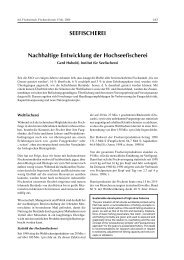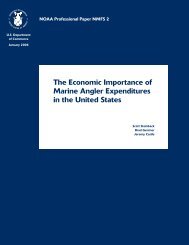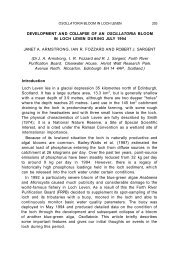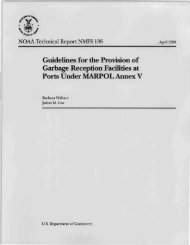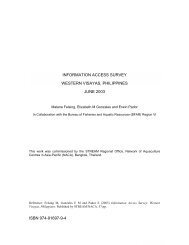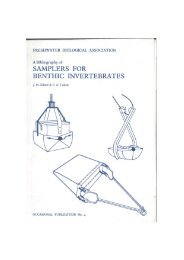Download (36Mb) - Aquatic Commons
Download (36Mb) - Aquatic Commons
Download (36Mb) - Aquatic Commons
You also want an ePaper? Increase the reach of your titles
YUMPU automatically turns print PDFs into web optimized ePapers that Google loves.
August 15, 1914 HISTORICAL CALENDAR August 15, 1939<br />
1906.-February 5: The International Board of Consulting<br />
Engineers submitted a majority report, signed by<br />
eight members, recommending a sea-level canal, and a<br />
minority report, signed by five members, recommending a<br />
lock-type canal.<br />
June 29: The President approved an act passed by both<br />
houses of Congress prescribing that a lock-type canal be<br />
built.<br />
November 14: President Theodore Roosevelt arrived<br />
in Cristobal to inspect the Canal construction work. It<br />
was the first time any Chief Executive had left the continental<br />
United States while in office.<br />
1907.-March 4: Theodore P. Shonts resigned as Chairman<br />
of the Isthmian Canal Commission and John F.<br />
Stevens was appointed as Chairman and Chief Engineer.<br />
This was the first time the office of the Chairman of the<br />
Isthmian Canal Commission was located on the Isthmus.<br />
April 1: John F. Stevens resigned and the appointment<br />
of Lt. Colonel George W. Goethals as Chairman and Chief<br />
Engineer of the Isthmian Canal Commission became effective.<br />
At the same time the ap'pointment of new members<br />
of the Isthmian Canal Commission to replace those who<br />
had resigned or had been transferred to duties elsewhere<br />
became effective. The new commission was composed of<br />
the following members: Lt. Col. Goethals, Chairman and<br />
Chief Engineer; Col. W. C. Gorgas, Lt. Col. D. D. Gaillard,<br />
Lt. Col. H. F. Hodges, Maj. William L. Sibert, J. C. S<br />
Blackburn, and Rear Admiral H. H. Rousseau.<br />
October 4: The first serious landslide occurred in Culebra<br />
Cut. Two steam shovels were buried, and all railway<br />
track in the Canal prism for a distance of 1,000 feet was<br />
covered. Approximately 500,000 cubic yards of material<br />
moved into the Cut.<br />
1908.-The highest record for excavation in anyone year<br />
in the Canal's construction was set in this year when more<br />
more than 37,000,000 cubic yards of spoil were taken from<br />
the Canal prism.<br />
1909.-January 29: Secretary of War Taft and a commission<br />
of seven eminent civil engineers arrived in Cristobal<br />
to inspect the Canal work and especially Gatun Dam,<br />
the construction of which had been severely criticized<br />
The commission was composed of the following: Frederic<br />
P. Stearns. Arthur P. Davis, Henry A. Allen, James D.<br />
Schuyler, Isham Randolph, Allen Hazen, and John R.<br />
Freeman. On its return to the United States the commission<br />
submitted a favorable report to President Roosevelt on<br />
Gatun Dam and the feasibility and safety of the locks and<br />
other engineering features involved in the construction of<br />
the Canal.<br />
March: A total of 4,062,632 cubic yards of material<br />
were removed from the Canal prism during the month of<br />
March. This was the record month during Canal construction<br />
and the only month in which excavation exceeded<br />
4,000,000 cubic yards.<br />
August 24:<br />
First concrete poured for Gatun Locks.<br />
September 1: First concrete poured for Pedro Miguel<br />
Locks.<br />
1910.-May 30:<br />
Locks.<br />
First concrete poured for Miraflores<br />
November 14: President William Howard Taft disembarked<br />
in Cristobal from the U. S. S. Tennessee for a threeday<br />
visit.<br />
1912.-May 25: The work of relocating the Panama<br />
Railroad was completed and the road was formally transferred<br />
to the Panama Railroad Company.<br />
August 24: The Panama Canal Act providing for the<br />
permanent organization for the operation and maintenance<br />
of the Panama Canal was approved by the President.<br />
1913.-May 18: The waters of the Pacific Ocean were<br />
let into the Canal channel when the dike across the newly<br />
dug channel near Corozal was blown up.<br />
September 26: Gatun Locks were operated for the<br />
first time when the tugboat Gatun was locked through.<br />
October 10: The waters of the Pacific and Atlantic<br />
oceans were united when Gamboa dike was blown up at<br />
2 o'clock in the afternoon. The charge of dynamite was<br />
set off by President VI oodrow Wilson in Washington. D. C.<br />
October 14: The Pacific Locks were used for the first<br />
time when some dredging equipment was locked through<br />
Miraflores Locks.<br />
1914.-January 7: The crane boat AtexLaValley made<br />
the first trip of a steam-propelled vessel through the<br />
Panama Canal.<br />
January 27: President Woodrow Wilson issued an<br />
Executive Order establishing the organization for the completion,<br />
operation, maintenance, government, and sanitation<br />
of the Panama Canal and its adjuncts, and the government<br />
of the Canal Zone to become effective April 1, 1914.<br />
February 4: Colonel George W. Goethals was appointed<br />
first Governor of The Panama Canal.<br />
August 15: The first commercial transit of the Panama<br />
Canal by an ocean-going vessel was made by the Panama<br />
Railroad Company's twin-screw steamer Ancoll.<br />
October 14: A disastrous slide occurred just north of<br />
Gold Hill and blocked the Canal channel to the passage of<br />
vessels larger than a towboat.<br />
1924.-July 23: The H. M. S. Hood transited the<br />
Panama Canal. It is the largest warship which has tran·<br />
sited the Canal. It also paid the largest amount of tolls<br />
ever collected for the transit of any vessel. The Hood had<br />
a displacement tonnage of 44,800 tons and paid 22,400 in<br />
tolls.<br />
1932.-Aprill: The Canadian liner Empress of Britain<br />
transited the Canal, paying $18,985 in tolls, the larl;'est<br />
amount of tolls ever paid by a commercial vessel. Until<br />
1939 the Empress of Britain also held the record for the<br />
largest commercial vessel to transit the Canal.<br />
1934.-July II: President Franklin Delano Roosevelt<br />
arrived in Cristobal aboard the U. S. S. Houston for a brief<br />
visit to the Canal Zone and the Republic of Panama. He<br />
transited the Canal on the cruiser, being the first Chief<br />
Executive of the United States to transit the Panama<br />
Canal.<br />
1935.-0ctober 16: President Franklin Delano Roosevelt<br />
arrived in Balboa aboard the U. S. S. Houston for his<br />
second visit to the Panama Canal while Chief Executive.<br />
1938.-August 4: President Franklin Delano Roosevelt<br />
visited the Canal Zone on his return trip to Washington<br />
after his summer vacation.<br />
October 10: The 100,000th transit of the Panama<br />
Canal by a commercial vessel of more than 300 tons net<br />
was made by the S. S. Steel Exporter, a 5,000-ton vessel<br />
flying the American flag en route from Los Angeles to<br />
London with a general cargo.<br />
1939.-February 15: The orth German Lloyd liner<br />
Bremen transited the Canal. It is the largest vessel of any<br />
kind which has transited the Canal. It has a gross tonnage<br />
of 52,896, and a displacement tonnage of 57,760.<br />
February 17: The S. S. Washington, flagship of the<br />
United States Lines, and largest vessel of the American<br />
merchant marine, transited the Canal.<br />
August 15: The silver anniversary of the opening of<br />
the Panama Canal to commercial traffic was observed as<br />
a legal holiday on the Canal Zone. The S. S. Ancon reenacted<br />
its historic voyage through the Canal which was<br />
made just 25 years before.<br />
Page oue hundred and eleven




